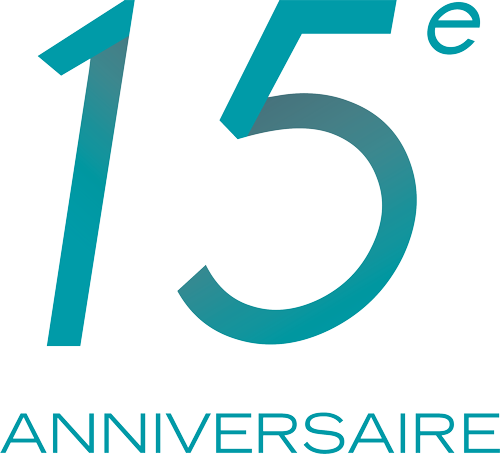Ville-Marie borough
REALTA, your Montreal real estate agency, presents the Ville-Marie Borough. This is the heart of Montreal, its historic, economic, social and tourist hub. It includes the downtown core, famous for its soaring skyscrapers, and 10 distinct neighborhoods, each with its own unique history, ambience and attractions. A must-see destination, it’s the place to go for entertainment, shopping, study, business or just for a stroll. More than half a million people pass through every day. The borough is also an attractive residential area. With over 104,000 inhabitants, downtown Montreal is one of the most densely populated areas in North America.
For the heart of Montreal
The Ville-Marie borough occupies the central part of the island, between Mount Royal and the St. Lawrence River. It is surrounded by the city of Westmount and the boroughs of Côte-des-Neiges-Notre-Dame-de-Grâce, Outremont and Plateau-Mont-Royal. With a surface area of 16.5 km², it also includes the islands of Sainte-Hélène and Notre-Dame in the St. Lawrence River.
In fact, these islands are popular destinations, as they include La Ronde, an amusement park that attracts thrill-seekers every year, Parc Jean-Drapeau with its beach and 25 km of bike paths, and finally the Casino de Montréal.
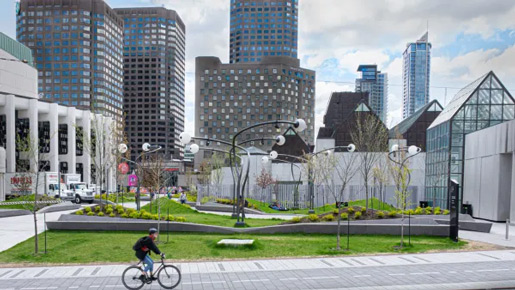
An important area of the Ville-Marie borough: Place des Arts, with the Complexe Desjardins towers in the background. Source : Ville de Montréal
For his story
Archaeological research shows that the area was occupied as far back as 2,500 or 3,000 years ago.Closer to home, Paul de Chomedey de Maisonneuve and a group of French settlers established a French colony called Ville-Marie in 1642.
The city has undergone many transformations over the centuries, evolving from a small fortified village to a commercial and cultural hub of international importance.For almost 200 years, Montreal was limited to the present-day Ville-Marie borough, until industrialization and urbanization pushed back the city’s boundaries.
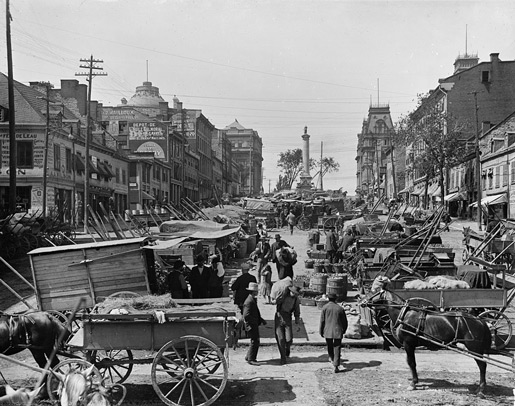
Place Jacques-Cartier in 1900.Photograph by Jackson, William Henry, 1843-1942. Source: Prints and Photographs division of the U.S. Library of Congress.
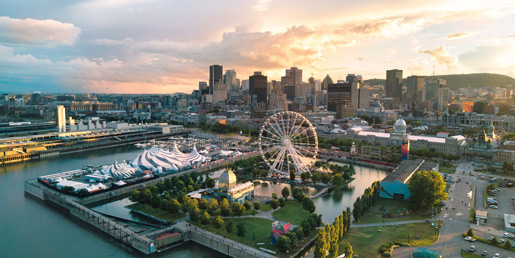
An aerial view of the Old Port and Old Montréal, with downtown skyscrapers and Mount Royal in the background. Source: Tourisme Montréal
For its neighborhoods
Old Montreal and Old Port district
Old Montreal and the Old Port are Montreal’s historic jewels. Old Montreal is the city’s historic district, steeped in nearly 400 years of history. It is distinguished by its cobblestone streets, stone buildings and old-world atmosphere. Here you’ll find historic sites to visit, as well as boutiques and restaurants tucked away.
For its part, the Old Port is a recreational tourism site offering a variety of family, nautical and leisure activities. Together, they have attracted more than 6 million visitors annually over the past 25 years, as well as more than 35,000 daily workers. The construction of buildings, mainly condominiums, has encouraged population growth, from 500 inhabitants in 1976 to over 7,500 in 2016.
Chinatown
Chinatown is a historic site located north of Old Montreal. It was established by Chinese immigrants from Western Canada in the late 19th century. Its boundaries are defined by avenue Viger, rue Saint-Urbain, boulevard René-Lévesque and boulevard Saint-Laurent. Chinatown is essentially a service and business hub.
Its narrow streets are lined with stores offering exotic foods, traditional handicrafts, martial arts accessories, natural herbs and medicines, and even oriental medicine and acupuncture services. Countless Chinese newspapers, organizations and associations in Quebec are housed in the district’s buildings. In 2023, the heart of Montreal’s Chinatown was designated a heritage site by the Quebec government.

A popular event presented in the Quartier Latin (rue St-Denis). It's the Festival Montréal Complètement Cirque.quartierlatin.ca
Latin district
The Quartier latin is located east of the Quartier des Spectacles and west of the Centre-Sud and the Village. The origin of the name Quartier Latin dates back to 1876, when Université de Laval, which later became Université de Montréal (1919), set up one of its pavilions here. At the time, the Quartier Latin was one of French America’s leading intellectual centers. Today, life in this district revolves around the Université du Québec à Montréal, the Cégep du Vieux-Montréal and rue Saint-Denis.
Transformed in the 1960s, it now blends tradition and modernity through its renovated historic buildings, boutiques, restaurants and theaters. The district is home to a diverse population, including students, artists, creative professionals and long-term residents, enriching its social and cultural fabric. Visitors are attracted by its remarkable architecture, picturesque streets, art galleries and vibrant nightlife. With its bars, clubs, cafés, restaurants and festivals, the Quartier Latin is a popular Montreal destination.
The Village
Since the 1970s, the Gay Village has been an essential refuge for the LGBTQ+ community. Located between rue Sherbrooke to the north, boulevard René-Lévesque to the south, rue Papineau to the east and rue Saint-Hubert to the west, this district is famous for its main thoroughfare, rue Sainte-Catherine. It’s alive with a rich and varied cultural and leisure offering, including a multitude of LGBTQ+ bars, clubs, restaurants, boutiques and cafés, as well as theaters, art galleries and community centers.
What’s more, the district comes alive with the various events it hosts every year, attracting between 2 and 3 million people a year. In short, the Village stands out as a destination of choice, radiating dynamism and inclusiveness. It welcomes a mosaic of people from all walks of life, far beyond the LGBTQ+ community alone, bringing together individuals of various ages, cultures and socio-economic backgrounds.
International district
Located between downtown and Old Montreal, the Quartier International is home to 25 head offices, 65 international organizations, 7 universities, 1,200 bars and restaurants, 300 terraces, 40 hotels and 60 cultural establishments.
Major buildings include the Palais des congrès de Montréal, the Centre CDP Capital, the Montreal World Trade Centre, the Tour de la Bourse and the Hôtel InterContinental Montréal. All these buildings are linked by the underground pedestrian network (RESO) between Bonaventure, Square-Victoria and Place-d’Armes metro stations. It’s a very busy district, with 300,000 jobs, 135,000 students and 11 million tourists.
Museum District
The Quartier du Musée is a veritable haven of discovery for art and history lovers.It encompasses the area between Sherbrooke to the north, De Maisonneuve to the south, Saint-Matthieu to the west and Drummond to the east. Most of these commercial streets are home to high-end stores, art galleries, jewelers, decorating and fashion boutiques, as well as restaurants.
Within walking distance, you can explore the Montreal Museum of Fine Arts, the McCord Museum and the Musée d’art contemporain de Montréal, where you can admire world-renowned masterpieces. Another popular activity is a stroll through the area’s picturesque streets to admire the architecture of the beautiful homes, some of which date back to 1840.
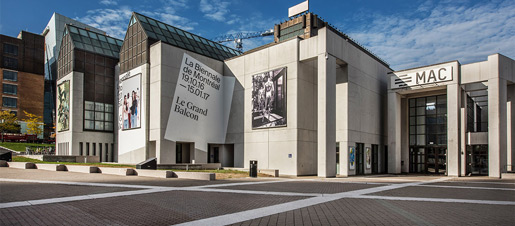
Musée d'art contemporain de Montréal (MAC), located in the entertainment district. Source : placedesarts.com.
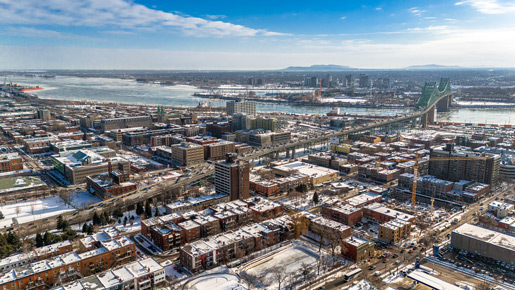
Aerial view of part of the Quartier Sainte-Marie in the shadow of the Jacques-Cartier Bridge
The Sainte-Marie district
Located just east of downtown, Quartier de Sainte-Marie is the most residential part of the Ville-Marie borough, with over 30,000 residents. It’s a beautiful neighborhood close to all that’s happening in Montreal. It is bordered by Sherbrooke Street to the north, the rail yard to the east, Notre-Dame Street to the south and Papineau Avenue to the west.
Formerly known as “le Faubourg à m’lasse”, it retains traces of its industrial and working-class past, while transforming itself into a dynamic and attractive neighborhood. It boasts a number of distinctive features, including high-quality community facilities, easy access to public transit, a dynamic community environment and an emerging cultural economy.
Entertainment district
The Quartier des spectacles is a unique place in Montreal. It’s the ideal place to discover Montreal culture, art and local and international music, with its 40 annual festivals. Covering an area of 1 km², it features more than 80 cultural venues: 8 lively public squares year-round, some 40 concert halls and bars with over 28,000 seats, some 40 exhibition spaces and several cinemas. Place-des-Arts is the jewel in the crown. These are just some of the platforms where established and emerging artists alike meet audiences of all ages.
Watch this video of a bird’s-eye view of Quartier des spectacles. Source: @Quartierdesspectacles
Shaughnessy Village
Located halfway between downtown Montreal and Westmount, Shaughnessy Village is full of little wonders that are still too little known to the general public. It’s a vibrant, colorful neighborhood that perfectly blends history and modernity. Once known as the “tannery district”, it has become a popular place to live for artists, students and young professionals.
The district is bordered by Bishop Street to the east, Sherbrooke Street to the north, Atwater Street to the west and the Ville-Marie expressway to the south. It has become a favorite thanks to its myriad of culinary addresses specializing in the flavors of the Far East. Here, you’ll enjoy authentic Japanese, Korean, Chinese and Vietnamese cuisine.
Faubourgs district
Located east of downtown Montreal, between Sherbrooke to the north, De Maisonneuve to the south, Saint-Hubert to the west and De Lorimier to the east, the Quartier des Faubourgs offers residents a peaceful living environment, close to the city’s amenities and attractions. The area is a hotbed of cultural activity, home to numerous creative studios, theaters and exhibition spaces, as well as various cultural organizations and the artists who work there. To consolidate and revitalize the area, the Ville-Marie borough wishes to make it a recognized cultural district, bounded by the central axis of Ontario Street East.
Multimedia City
La Cité du Multimédia is a district created in 1998 south of downtown Montreal, in the area formerly known as Faubourg des Récollets. It is known as a major hub for the information and communications technology industry. Since its creation, Cité du Multimédia has been primarily a professional services and industrial district.
However, the development of modern condos and apartments is increasingly attracting young professionals and technology workers looking to live close to their place of work. This district plays a key role in the Montreal economy, generating jobs, stimulating innovation and attracting investment.
Havre City
Cité du Havre is a unique neighborhood established on the peninsula formerly known as Mackay Pier, southwest of the Port of Montreal. With a population of around 800, this area combines residential and commercial zones, with the exception of its tip, which is dedicated to a park. Developed mainly in the 1960s, using fill from the excavation of the metro and Place Ville-Marie, Cité du Havre was marked by the arrival of Expo 67 and the creation of Habitat 67.
Shortly afterwards, this structure became an architectural symbol of the city and, in fact, offers a unique living environment. The Cité du Havre is also known for the Habitat 67 wave, a maritime attraction for kayakers and river surfers, generated by the river’s Sainte-Marie current. East of Habitat 67, Dieppe Park offers green spaces, bike paths and walking trails, as well as exceptional views of the St. Lawrence River, the Old Port and downtown Montreal.
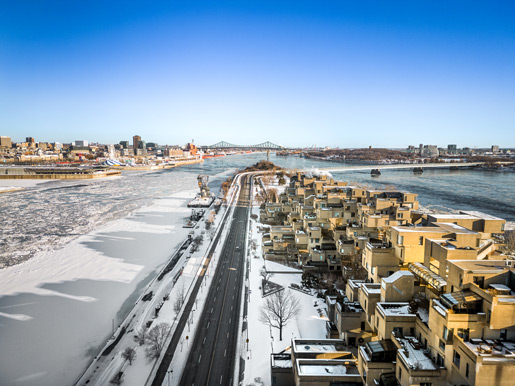
Aerial view of Habitat 67
Concordia district
The name given to the area surrounding Concordia University, known for its lively student life and numerous cafés and bookstores.
Golden Square Mile
Once Canada’s wealthiest district, it’s famous for its sumptuous Victorian mansions.
The district in figures :
- Population: 104,944 people, 6,353 inhabitants per km².
- Average age: 40 versus 38.6 for Montreal as a whole
- Surface area: 16.5 km²
- Persons per household: 1.7 persons per household on average – One-person households: 55% – Two-person households: 31% – Single-person households: 55% – Two-person households: 31% – Single-person households: 55% – Two-person households: 31% – Two-person households: 35
- Average income: $71,288
- Renters: 73%
- Owners : 27%
- Immigration: almost 43% of residents are foreign-born
- Languages spoken: 54% French and English, 19% French only, 27% English only and 20% other languages
- College and university graduates in the 25-64 age group: 67%.
Sources: Statistics Canada, Centris and Immigrant Québec
- 1 house of culture
- 2 libraries
- 13 micro libraries
- 141 parks and green spaces
- 12 community gardens
- 1 arena
- 6 outdoor rinks
- 4 indoor pools
- 1 outdoor pool
- 3 outdoor children’s pools
- 11 water games
- 2 beaches
- 2 major universities
- 5 higher education institutions
- 15 subway stations
- 22 museums
- 50 concert halls
- 1500 restaurants
- More than 3,000 stores
- 13 pedestrian zones
- 2 public Markets
- 1 community greenhouse
- 1 underground network (RESO), including a pedestrian network covering some thirty kilometers of corridors, tunnels and shopping plazas.
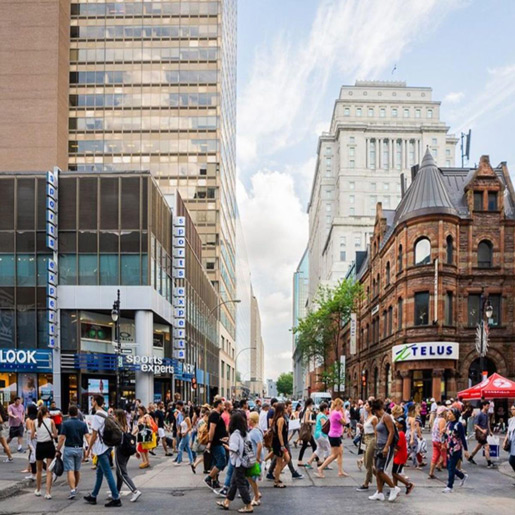
Sainte-Catherine Street is Montreal's main commercial thoroughfare. The Sun Life Building can be seen in the background. Source : Bonjour Québec.
For its commercial streets
Sainte Catherine Street
Sainte-Catherine Street is Montreal’s most important commercial street, stretching over 11.2 km2 and home to nearly 1,200 stores, including some 450 with street frontage. The downtown portion is home to the city’s biggest department stores, including The Bay, Simons and Ogilvy. It’s also home to a number of boutiques and shopping malls: Cours Mont-Royal, Place Montréal Trust, Centre Eaton, Promenades Cathédrale, Complexe Desjardins and, just around the corner, Place-Ville-Marie.
It is also known as a vibrant center of cultural and social activity. The green line of the Montreal metro provides easy access. The street runs through several important neighborhoods, offering a variety of attractions and services: shops of all kinds, places of worship, green spaces, lively sectors and major cultural venues, principally the Quartier des spectacles, Place des Arts, Théâtre du Nouveau-Monde and Foufounes électriques.
Sherbrooke Street
Sherbrooke Street is Montreal’s main artery. One of the longest streets on the island, at 32 kilometers, it is a major thoroughfare, as evidenced by its status as a provincial highway (R112). It is recognized for its historical and cultural importance, home to prestigious institutions such as McGill University and the Montreal Museum of Fine Arts, and sites such as Parc Lafontaine and the Olympic Stadium.
Once a bastion of affluent Montreal families, the western part of the street, in the downtown core, is now dotted with hotels, boutiques, antique shops, art galleries and many other types of stores. The eastern part of Saint-Denis features a larger number of residences and a few commercial blocks.
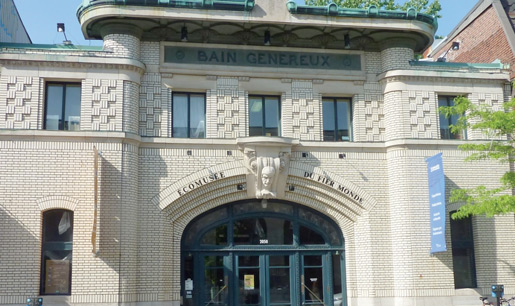
L'Écomusée du fier monde, a history museum and citizen's museum, invites you to explore the history of work and reflect on the social issues of its environment. The museum is housed in the former Généreux public bath, a magnificent example of 1920s architecture. It's just a few houses down from Ontario Street, opposite Marché Saint-Jacques, Montreal's oldest public market. Source : museesmontreal.org.
Ontario Street
Far from being a simple side street, Ontario Street runs through Ville-Marie and Mercier-Hochelaga-Maisonneuve, offering a unique experience. In Mercier-Hochelaga-Maisonneuve, it becomes particularly commercial, with the Promenade Ontario area brimming with a variety of shops.
In Centre-sud, Ontario Street is the central axis of the cultural district that the borough wishes to create thanks to the Société de promotion des arts gigantesques (S.P.A.G.). Fifteen majestic mosaic murals by Laurent Gascon celebrate Quebec artists and creators along this street, which is itself historic, having been founded in 1842.
Saint-Denis Street
Saint-Denis Street, one of Montreal’s central and vibrant thoroughfares, stretches 11 kilometers from north to south, crossing key boroughs each with its own distinct charms and attractions. The section in Ville-Marie stretches from Sherbrooke Street to Saint-Paul Street in Old Montreal. It’s renowned for its abundance of cafés, terraces, restaurants, bookstores and specialty stores.
Initiated in the early 19th century, Saint-Denis gradually transformed itself from a residential district favored by the French-Canadian elite to a highly commercial sector. Towards the beginning of the 20th century, it acquired a significant intellectual and cultural dimension, particularly in the segment between René-Lévesque Boulevard and Sherbrooke Street, becoming a symbol of Montreal’s evolution and energy.
Today, life on this street revolves around institutions such as UQAM, Cégep du Vieux-Montréal, Théâtre Quartier latin (formerly Saint-Denis), Bibliothèque nationale du Québec and Centre hospitalier CHUM.
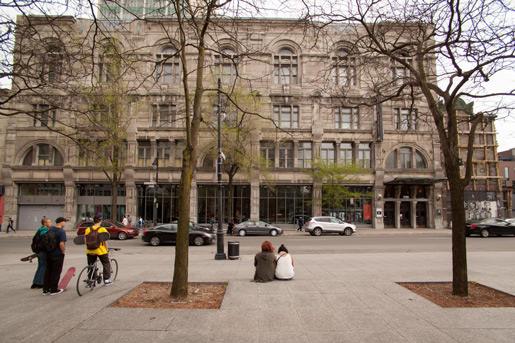
The Monument-National is a neo-Renaissance sociocultural building built between 1891 and 1894. It is classified as a heritage building. Source : Ville Montréal.
Saint-Laurent Street
Nicknamed “The Main”, Boulevard Saint-Laurent is an emblematic thoroughfare of the city, recognized for its historical, cultural and social importance. In 1996, the Government of Canada recognized it as a National Historic Site.
It runs from the south to the north of the island of Montreal, traditionally dividing the city into east and west sectors. Boulevard Saint-Laurent was laid out in the early 18th century, initially as a link between the village of Saint-Laurent and the city of Montreal. Over the years, it has become a focal point for various waves of immigrants, who have established businesses and vibrant communities here.
It’s a commercial artery that caters to all styles, from the very trendy to specialized ethnic shops. In Ville-Marie, the boulevard descends from Sherbrooke Street to Chinatown. Here you’ll find the Society for Arts and Technology, Club Soda, the Monument-National / National Theatre School of Canada, the Just for Laughs Festival and two survivors of the Red Light era: the Café Cléopâtre (1924) and the Montréal Pool Room (1912).
Notre-Dame Street
Rue Notre-Dame is Montreal’s second most important thoroughfare, running 35 km along the St. Lawrence River and crossing a large part of the island on its southeastern flank. It begins at the Saint-Pierre interchange and ends at the eastern tip of the island.
Created in 1672, Notre-Dame Street is rich in history and architecture, home to such landmarks as Place d’Armes, Notre-Dame de Montréal Basilica, Château Ramezay, Montreal City Hall, the Palais de Justice and Place Jacques-Cartier. The street runs through a variety of neighborhoods and towns, from Pointe-aux-Trembles to Lachine, and is dotted with remarkable buildings and green spaces. Today, it is characterized by a variety of uses, from residential areas to commercial and tourist zones, industrial spaces and parks.
For its musical events
Downtown Montreal vibrates to the rhythm of numerous festivals and musical events, including the Festival International de Jazz de Montréal, Osheaga, Festival Montréal en Lumière, L’International des Feux Loto-Québec, Igloofest, Les Francofolies, Mutek, Sous les glaces, Montréal en fêtes, Grand Prix cycliste and Fierté Montréal.
The Old Port of Montreal contributes with events such as Nuit blanche, Soirées à thème musicals, DJ sur Glace, Semaine de Relâche and Cirque du Soleil. And let’s not forget the Canadian Grand Prix, held on Île Notre-Dame’s Circuit Gilles-Villeneuve!
For its sports facilities
Centre Bell : iconic arena hosting Montreal Canadiens games, major sporting events and concerts.
Parc Jean-Drapeau : site of many sporting events, including the Formula 1 Canadian Grand Prix.
His parks
Parc du Mont-Royal : offers a green escape with breathtaking views over the city.
Square Dorchester et Place du Canada : green spaces in the heart of downtown.
Parc Lafontaine, on the northern boundary of the borough (Sherbrooke street).
For its real estate market
The real estate market in Ville-Marie is dynamic, offering a varied range of properties. It appeals to a varied clientele, both local and international. The borough is highly sought-after for its architectural diversity and lively atmosphere, including shopping malls, skyscrapers, luxury apartments, historic buildings, churches, restaurants and cafés. Whether you’re looking for an elegant pied-à-terre, a spacious family residence or a promising rental investment, Ville-Marie has something for everyone.
What types of property are there?
The real estate market in Ville-Marie is constantly evolving. Demand is strong and prices are generally high. Prices can vary considerably depending on the neighborhood, property type and location.
The borough encompasses a variety of properties, from modern condos and lofts in renovated buildings to apartments in older buildings. The real estate offering also includes single-family homes, luxury penthouses and commercial space, both at street level and in skyscrapers. According to Centris, there were 1,949 properties for sale in the borough as of February 2024.
Here’s an overview of the main types of property you can find in the borough:
- Condos: Concentrated mainly downtown, these offer spectacular views, high-end finishes and concierge services. This category includes luxury penthouses. Centris counted 1,706 units.
- Single-family homes: These are rare, with 74 units, and generally located in the Golden Square Mile and the Sainte-Marie and Faubourg neighborhoods.
- Duplexes, triplexes and fourplexes: Centris has identified 50 plexes for sale, mainly in the Sainte-Marie, Faubourgs and Village neighborhoods. Attractive income potential for investors.
- Lofts/Studios: More often than not, these are industrial spaces converted into homes, often with large windows and high ceilings. Centris counted 55 in the borough.
- Lots and interiors: Yes! there are still a few lots for sale in the borough. However, garage interiors dominate this category (90%), which includes 50 units.
Investors:
- Given its continued growth and potential for value enhancement, Ville-Marie is a magnet for real estate investors. The area is undergoing sustained development, with new residential and commercial projects designed to meet growing demand.
- The rental market is equally dynamic in Ville-Marie, offering a range of options for different budgets and lifestyles. Rental apartments range from studios for students to luxury units for professionals and families.
- Invest in condos, plexes and single-family homes.
Retired:
- Looking for an active, accessible lifestyle.
- Enjoy serviced condos and spacious apartments.
- Looking for security.
- Appreciate proximity to shops and healthcare facilities.
Art and culture lovers:
- Enjoy the proximity of museums, theaters and art galleries.
- Looking for unique lofts and apartments.
Students:
- Prefer neighborhoods close to universities and public transport.
- Looking for affordable studios and apartments.
What kind of people are renters or owners?
The Ville-Marie borough, the vibrant heart of Montreal, attracts a wide variety of people to rent or buy property. Its dynamism, attractions and variety of property types make it a coveted location for many profiles.
Here’s an overview of the main types of property you can find in the borough:
Young professionals:
- Enjoy proximity to business centers, restaurants and bars.
- Looking for modern, well-located condos.
Families:
- Benefit from the many services and amenities on offer, such as schools, parks and daycare centers.
- Prefer quieter neighborhoods such as Sainte-Marie and des Faubourgs.
Homeowners versus renters
Source : Centris
Update : February 2024
Median price
Single-family homes
Source : Centris
Update : February 2024
Median price
Condominium
Source : Centris
Update : February 2024
Ville-Marie, my real estate agency is Realta!
If you’re looking to buy or sell a property in the Ville-Marie borough, don’t hesitate to contact one of REALTA’s professional real estate brokers. He or she will be able to guide and advise you every step of the way. REALTA real estate brokers are familiar with the local Ville-Marie market and have the tools they need to assess a property’s value, negotiate the best price and draw up the legal documents. You can trust our experts to make your real estate dream come true!

Information sources and useful links
- Ville de Montréal
- Site Internet de l’Arrondissement Ville-Marie
- Portrait de l’arrondissement de Ville-Marie
- Arrondissement de Ville-Marie – Profil démographique
- Habiter Ville-Marie – Table de Concertation en Logement
- Les faubourgs de Montréal, évolutions et confusions
- Les piétonnisations au cœur de Ville-Marie
- Bienvenue au Centre-Ville de Montréal
- Mes Quartiers & C’est toi ma ville – Page Facebook
- Quartier culturel des Faubourgs
- Vieux-Montréal
- Vieux-Port
- Le Quartier Latin
- Quartier du Musée
- Quartier des spectacles
- Sainte-Marie : Un quartier à la croisée des chemins
- Quartier International
- Quartier chinois
- Shaughnessy Village
- La Cité Multimédia
- Cité-du-Havre
- Rue Sainte-Catherine
- Rue Sherbrooke
- Rue Notre-Dame
- Rue Saint-Denis
- Balado et Visite Virtuelle : rue Ontario
- Le boulevard Saint-Laurent à Montréal : une Main Street réinventée
